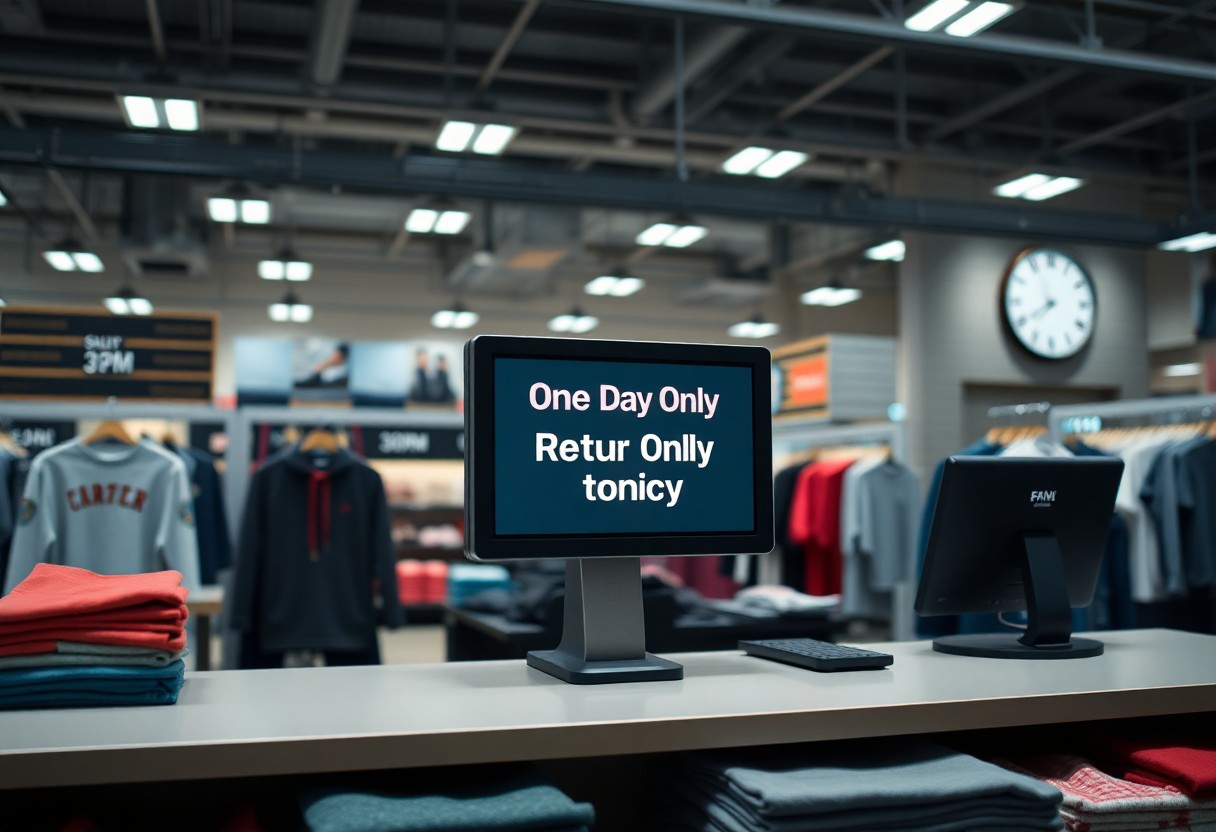Oneday, your shopping experience could take a surprising turn with a one-day return policy. This unique policy gives you a limited timeframe to decide whether a purchase meets your expectations, putting extra pressure on your decision-making. Understanding the positive aspects, such as immediate refunds and streamlined exchanges, can save you hassle. However, be aware of the potential pitfalls, including the risk of impulsive purchases or missing out on returning items completely. Knowing these factors helps you navigate your choices effectively.

The Rationale Behind a One-Day Return Policy
Customer Expectations and Instant Gratification
In today’s fast-paced retail environment, customer expectations have shifted dramatically towards instant gratification. You want to feel that your purchase decisions are validated immediately, and a one-day return policy aligns perfectly with that desire. By offering a limited window for returns, retailers cater to the psychological need for reassurance that their choices were right without prolonged doubts. This creates a safety net, allowing you to enjoy your purchase more fully, knowing that the option to return it is available without hassle.
The demand for immediate action also plays a role here. Customers are less tolerant of lengthy return processes; they desire convenience and efficiency. With a one-day return policy, you are empowered to try out products and decide swiftly if they meet your expectations. Such a policy sends a clear message about the retailer’s confidence in the quality of their products, further enhancing your trust in them.
Impact on Purchase Decisions
A one-day return policy can significantly influence your purchase decisions. The short timeframe not only encourages you to buy but also motivates you to act fast, weighing the product’s pros and cons on-the-spot. Knowing you have just one day to evaluate your purchase means you might be less hesitant about trying new items, as the low-risk nature of the policy eases concerns about making a wrong choice. Popular brands often leverage similar strategies to boost impulse buys, effectively making the decision-making process feel less daunting.
Statistics show that retailers with flexible return policies experience a 30% increase in conversion rates, indicating that a reassuring return option can make all the difference. Options like these not only influence your buying behavior but can create a sense of urgency, leading to more sales transactions, particularly for online shopping where physical evaluation of products is unattainable.
Analyzing the Pros and Cons of Short Return Windows
| Pros | Cons |
|---|---|
| Encourages quicker purchasing decisions | Increased pressure on consumers |
| Reduces the potential for return fraud | Limited time to assess product fit or quality |
| Improves inventory turnover rates | Risk of buyer’s remorse |
| Can enhance store profitability | May deter cautious shoppers |
| Creates urgency and excitement | Frustration with rushed decisions |
| Aids in operational efficiency | Potentially negative customer experience |
| Enhances brand image for decisiveness | Requires clear communication of policy |
| Encourages customers to try more products | Complicated returns can lead to dissatisfaction |
Benefits for Retailers: Inventory Control and Profit Margins
A one-day return policy empowers retailers to streamline their inventory management processes. With products turning over faster, you can maintain a leaner stock, minimizing holding costs and reducing the risk of markdowns. This policy not only accelerates the restocking of best-sellers but also enhances the store’s ability to respond quickly to emerging trends, allowing you to capitalize on popular items as they gain traction.
In terms of profit margins, shorter return windows discourage habitual buyers who exploit generous return policies. You’ll notice fewer returns translating into better financial health for your business. Additionally, by promoting a one-day return policy, you can create a sense of urgency among consumers, encouraging immediate purchases that can further boost your sales figures.
Challenges for Consumers: Risk and Anxiety
The one-day return policy introduces significant risk and anxiety for you as a consumer. The pressure to make swift decisions can lead to impulsive purchases, ultimately resulting in buyer’s remorse. With insufficient time to evaluate your choices, you may find yourself stuck with items that don’t meet your expectations.
This policy can particularly disadvantage consumers who require more time to assess the quality or fit of products. For example, clothing shoppers may need to try on items in a relaxed timeframe to ensure the best fit, while tech buyers might need extended periods to test product functionality. The one-day limit can exacerbate feelings of frustration and disappointment when unable to return unsatisfactory purchases.
Time constraints can lead to a cycle of anxiety, as you rush to return items to avoid unwanted expenses. This added pressure diminishes the overall shopping experience, forcing you to reconsider what would typically be an enjoyable process. Such stress may lead to hesitancy in trying new brands or products, as the fear of making a poor purchase decision prevails over the potential benefits of innovation and exploration.
Crafting a One-Day Return Policy: Key Elements
Clear Terms and Conditions
A well-defined return policy begins with clear terms and conditions. Specify the products eligible for return, ensuring customers understand which items can be returned and which cannot. For example, if clothing can be returned but personalized items cannot, this should be evident upfront. Using bullet points or a simple FAQ format can facilitate easier comprehension, allowing customers to quickly refer to the guidelines without sifting through lengthy paragraphs.
Additionally, stipulate the exact timeframe for return initiation. State explicitly that returns must be initiated within one day of the purchase date. By setting this boundary, you help manage customer expectations and prevent potential misunderstandings regarding late returns. This transparency will forge trust and enhance customer satisfaction.
Seamless Return Process
Implementing a seamless return process is vital for a one-day return policy to succeed. Create a simple, hassle-free procedure that customers can follow, which ensures they can complete returns without complications. A straightforward online form or a printed label within the product packaging can guide the customer efficiently through the return journey. For instance, consider integrating return instructions directly into your mobile app, so they are just a tap away when customers need them.
Establishing convenient return options, such as local drop-off points or partnerships with shipping companies, reduces barriers for returns. By allowing customers to drop off items at their convenience or providing prepaid shipping labels, you create a frictionless experience that enhances your brand’s reputation and encourages future purchases. Make sure that support team members are also well-trained to assist customers promptly during the return process, further solidifying a positive company image.
Case Examples: Success Stories and Pitfalls
Retailers Excelling with One-Day Policies
Several retailers have masterfully implemented one-day return policies, leading to increased customer satisfaction and brand loyalty. For instance, Zara allows returns within a single day for items purchased both in-store and online. This approach minimizes hassle for customers, while the brand enjoys improved inventory turnover and a boost in repeat business. Such agility in returns reflects an understanding of their consumer base, fostering a sense of trust and reliability.
Similarly, Amazon has integrated one-day returns for select products, which has significantly enhanced the shopping experience. Offering same-day refunds when returns are dropped off at designated centers has driven customer engagement. With nearly 80% of customers reporting satisfaction with their return process, Amazon continues to capitalize on this aspect, ensuring their customers feel valued and catered to.
Brands Facing Backlash
Some brands have struggled with a one-day return policy, leading to negative consumer reactions. A notable example is Forever 21, which rolled out a one-day return window but faced backlash due to inadequate communication about the policy changes. Customers expressed frustration when rush deadlines led to confusion and unfulfilled expectations, undermining brand loyalty. The rush to accommodate rapid returns can sometimes backfire when expectations are not met.
Fashion Nova also encountered issues when launching a similar policy, as many customers received defective items that they could not return in time. This left consumers feeling cheated and frustrated, ultimately hurting the brand’s reputation. A policy may look appealing on paper, but without the infrastructure to support it, you risk alienating your customer base.

The Future of Return Policies: Trends to Watch
Tech Innovations in Returns Management
Advancements in technology are revolutionizing returns management, making the process smoother and more efficient for both retailers and consumers. Companies are increasingly utilizing artificial intelligence and machine learning to analyze return data, identify common trends, and predict potential return rates. This not only streamlines inventory management but also allows you, as a consumer, to enjoy a more personalized return experience that aligns with your unique preferences. For instance, augmented reality (AR) is enhancing virtual fitting rooms, reducing the likelihood of returns due to sizing issues.
Blockchain technology is also making significant strides in return policies by increasing transparency and trust in online transactions. With smart contracts on the blockchain, you can expect automated approval processes for returns, leading to faster refunds and clearer guidelines on what to expect. Incorporating these innovations positions retailers to adapt quickly to changes in the market and consumer behaviors.
Shifting Consumer Behaviors
Consumer expectations around return policies are evolving. A growing demand for flexibility drives retailers to offer more accommodating return windows, often extending beyond the traditional 30-day grace period. In a survey conducted by Narvar, 95% of consumers stated they would be likely to repurchase from a retailer that offers a hassle-free return process. This shift emphasizes the need for you to feel confident in your purchases, knowing that returning items is straightforward and stress-free.
As sustainability becomes a larger focus, environmental concerns are shaping your purchasing decisions. You are more likely to support companies that prioritize eco-friendly practices, including responsible disposal methods for returned products. Brands that adopt circular economy principles are likely to resonate more with you, ensuring that returns don’t contribute to wastefulness.
To wrap up
Ultimately, understanding the nuances of a one-day return policy can significantly impact your shopping experience. When you make a purchase, you must be aware of the time constraints associated with returning items. If you are dissatisfied or if the product does not meet your expectations, acting swiftly is crucial to ensure you adhere to the stipulated return timeframe.
This policy emphasizes the importance of inspecting your purchases immediately upon receipt. By doing so, you can make informed decisions about the items and initiate returns promptly if necessary. Being proactive about your rights as a consumer allows you to navigate these policies effectively, ensuring you have a satisfactory shopping experience.
FAQ
Q: What does the ‘return policy one day only’ mean?
A: The ‘return policy one day only’ means that customers have a single day from the date of purchase to return items for a refund or exchange. After this period, returns are not accepted.
Q: Are there any exceptions to the one-day return policy?
A: Yes, certain items may be exempt from the one-day return policy, such as final sale items, open software, or perishable goods. Always check the product details or ask customer service for specifics.
Q: How do I initiate a return under the one-day policy?
A: To initiate a return, contact customer service or visit the store within one day of your purchase. Be sure to bring your receipt and the item in its original condition for a smooth return process.